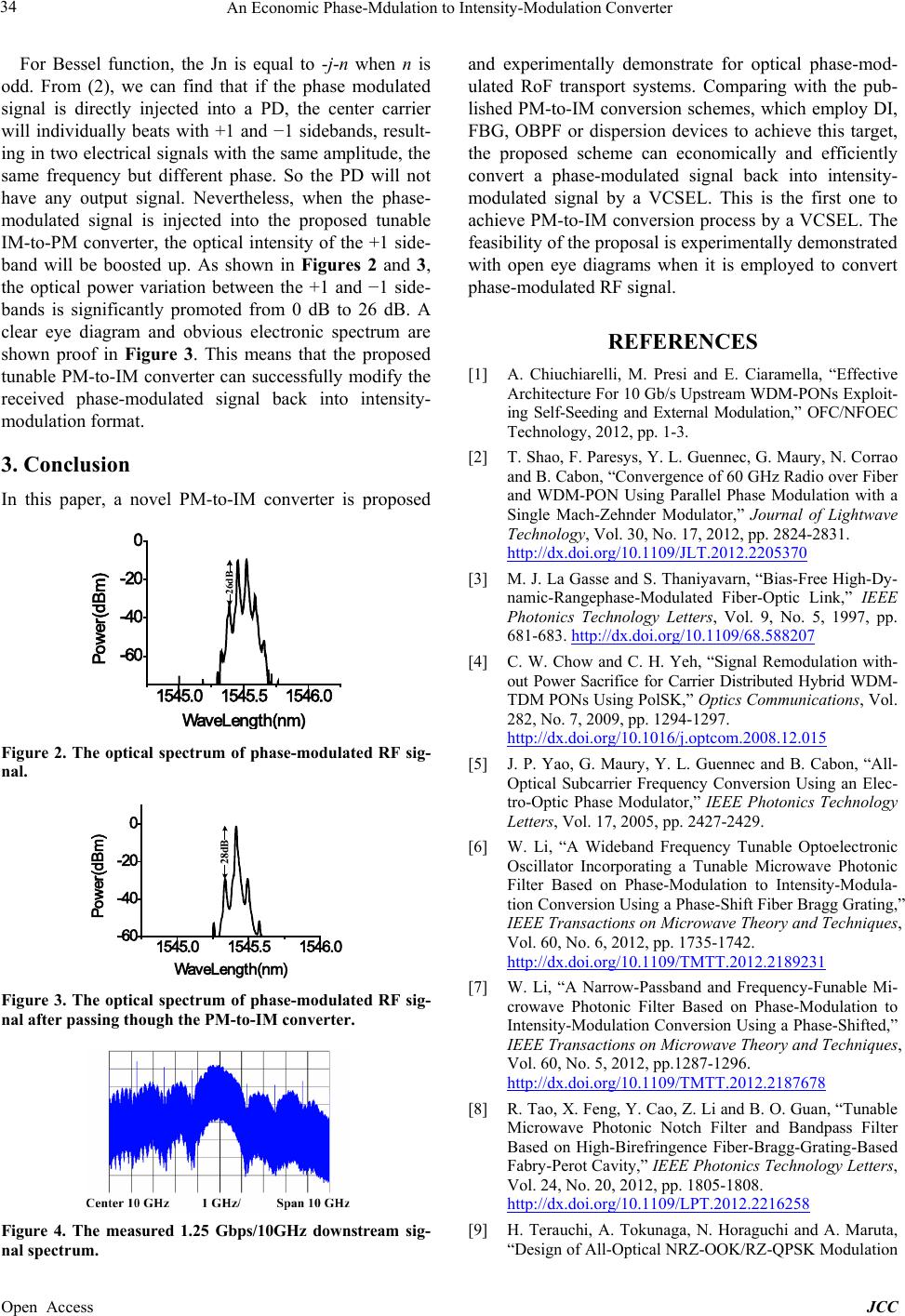
An Economic Phase-Mdulation to Intensity-Modulation Converter
Open Access JCC
For Bessel function, the Jn is equal to -j-n when n is
odd. From (2), we can find that if the phase modulated
signal is directly injected into a PD, the center carrier
will individually beats with +1 and −1 sidebands, result-
ing in two electrical signals with the same amplitude, the
same frequency but different phase. So the PD will not
have any output signal. Nevertheless, when the phase-
modulated signal is injected into the proposed tunable
IM-to-PM converter, the optical intensity of the +1 side-
band will be boosted up. As shown in Figures 2 and 3,
the optical power variation between the +1 and −1 side-
bands is significantly promoted from 0 dB to 26 dB. A
clear eye diagram and obvious electronic spectrum are
shown proof in Figure 3. This means that the proposed
tunable PM-to-IM converter can successfully modify the
received phase-modulated signal back into intensity-
modula t ion form a t .
3. Conclusion
In this paper, a novel PM-to-IM converter is proposed
Figure 2. The optical spectrum of phase-modulated RF sig-
nal.
Figure 3. The optical spectrum of phase-modulated RF sig-
nal after passing though the PM-to-IM converter.
Figure 4. The measured 1.25 Gbps/10GHz downstream sig-
nal spectr um .
and experimentally demonstrate for optical phase-mod-
ulated RoF transport systems. Comparing with the pub-
lished PM-to-IM conversion schemes, which employ DI,
FBG, OBPF or dispersion devices to achieve this target,
the proposed scheme can economically and efficiently
convert a phase-modulated signal back into intensity-
modulated signal by a VCSEL. This is the first one to
achieve PM-to-IM conversion process by a VCSEL. The
feasibility of the propos al is experimentally d emonstr ated
with open eye diagrams when it is employed to convert
phase-modulated RF signal.
REFERENCES
[1] A. Chiuchiarelli, M. Presi and E. Ciaramella, “Effective
Architecture For 10 Gb/s Upstream WDM-PONs Exploit-
ing Self-Seeding and External Modulation,” OFC/NFOE C
Technology, 2012, pp. 1-3.
[2] T. Shao, F. Paresys, Y. L. Guennec, G. Maury, N. Corrao
and B. Cabon, “Convergence of 60 GHz Radio over Fiber
and WDM-PON Using Parallel Phase Modulation with a
Single Mach-Zehnder Modulator,” Journal of Lightwave
Technology, Vol. 30, No. 17, 2012, pp. 2824-2831.
http://dx.doi.org/10.1109/JLT.2012.2205370
[3] M. J. La Gasse and S. Thaniyavarn, “Bias-Free High-Dy-
namic-Rangephase-Modulated Fiber-Optic Link,” IEEE
Photonics Technology Letters, Vol. 9, No. 5, 1997, pp.
681-683. http://dx.doi.org/10.1109/68.588207
[4] C. W. Chow and C. H. Yeh, “Signal Remodulation with-
out Power Sacrifice for Carrier Distributed Hybrid WDM-
TDM PONs Using Pol SK,” Optics Communications, Vol.
282, No. 7, 2009, pp. 1294-1297.
http://dx.doi.org/10.1016/j.optcom.2008.12.015
[5] J. P. Yao, G. Maury, Y. L. Guennec and B. Cabon, “All-
Optical Subcarrier Frequency Conversion Using an Elec-
tro-Optic Phase Modulator,” IEEE Photonics Technology
Letters, Vol. 17, 2005, pp. 2427-2429.
[6] W. Li, “A Wideband Frequency Tunable Optoelectronic
Oscillator Incorporating a Tunable Microwave Photonic
Filter Based on Phase-Modulation to Intensity-Modula-
tion Conversion Using a Phase-Shift Fiber Bragg Grating,”
IEEE Transactions on Microwave Theory and Techniques,
Vol. 60, No. 6, 2012, pp. 1735-1742.
http://dx.doi.org/10.1109/TMTT.2012.2189231
[7] W. Li, “A Narrow-Passband and Frequency-Funable Mi-
crowave Photonic Filter Based on Phase-Modulation to
Intensity-Modulation Conversion Using a Phase-Shifted,”
IEEE Transactions on Microwave Theory and Techniques,
Vol. 60, No. 5, 2012, pp.1287-1296.
http://dx.doi.org/10.1109/TMTT.2012.2187678
[8] R. Tao, X. Feng, Y. Cao, Z. Li and B. O. Guan, “Tunable
Microwave Photonic Notch Filter and Bandpass Filter
Based on High-Birefringence Fiber-Bragg-Grating-Based
Fabry-Perot Cavity,” IEEE Photonics Technology Letters,
Vol. 24, No. 20, 2012, pp. 1805-1808.
http://dx.doi.org/10.1109/LPT.2012.2216258
[9] H. Terauchi, A. Tokunaga, N. Horaguchi and A. Maruta,
“Design of All-Optical NRZ-OOK/RZ-QPSK Modulation
1545.0 1545.5 1546.0
- 60
- 40
- 20
0
Pow er(dBm)
WaveLengt h(nm)
1545.0 1545.5 1546.0
-60
-40
-20
0
Pow er(dB m)
WaveLength(nm)
28dB